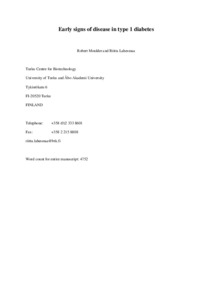Early signs of disease in type 1 diabetes
Robert Moulder; Riitta Lahesmaa
https://urn.fi/URN:NBN:fi-fe2021042715515
Tiivistelmä
As a severe chronic disease with long-term complications, type 1
diabetes (T1D) is a burden to the patients and their families as well as
a challenge to the health care system. T1D is a heterogeneous disease
with a variety of etiologies and a wide range in the rate of progression
to the disease. In order to prevent and treat T1D it would be important
to identify measures that could be used to predict and monitor disease
progression, as well as to further understand the molecular mechanisms
involved. During the past 20 yr since its initiation, the Finnish
Diabetes Prediction and Prevention Project (DIPP) has collected
longitudinal biological samples from children with a human leukocyte
antigen gene-conferred risk of T1D. This large sample collection has
provided detailed sample series that enable studies to map the
progression from health to disease, as well as the healthy maturation of
risk-matched children. The DIPP samples have been used in a large body
of research to elucidate the factors involved in the development of T1D.
Interestingly, results from recent studies exploiting omics platforms
have revealed that signs of the disease process can be detected very
early on, even prior to appearance of the first T1D-associated
antibodies, which are currently considered the earliest indications of
the emerging disease. Identification and validation of multi-modal
molecular markers will we hope provide a means to subgroup the
heterogeneous group of T1D patients and enable prediction, diagnosis,
and monitoring of T1D. Discovery of such markers is important in the
design and testing of prevention and therapies for T1D
Kokoelmat
- Rinnakkaistallenteet [19249]
